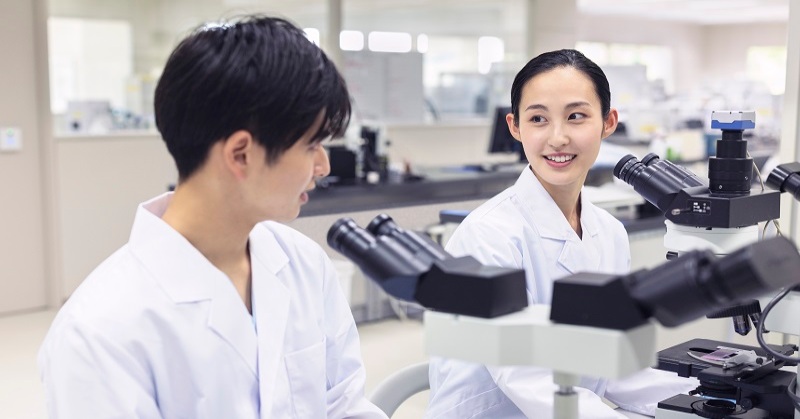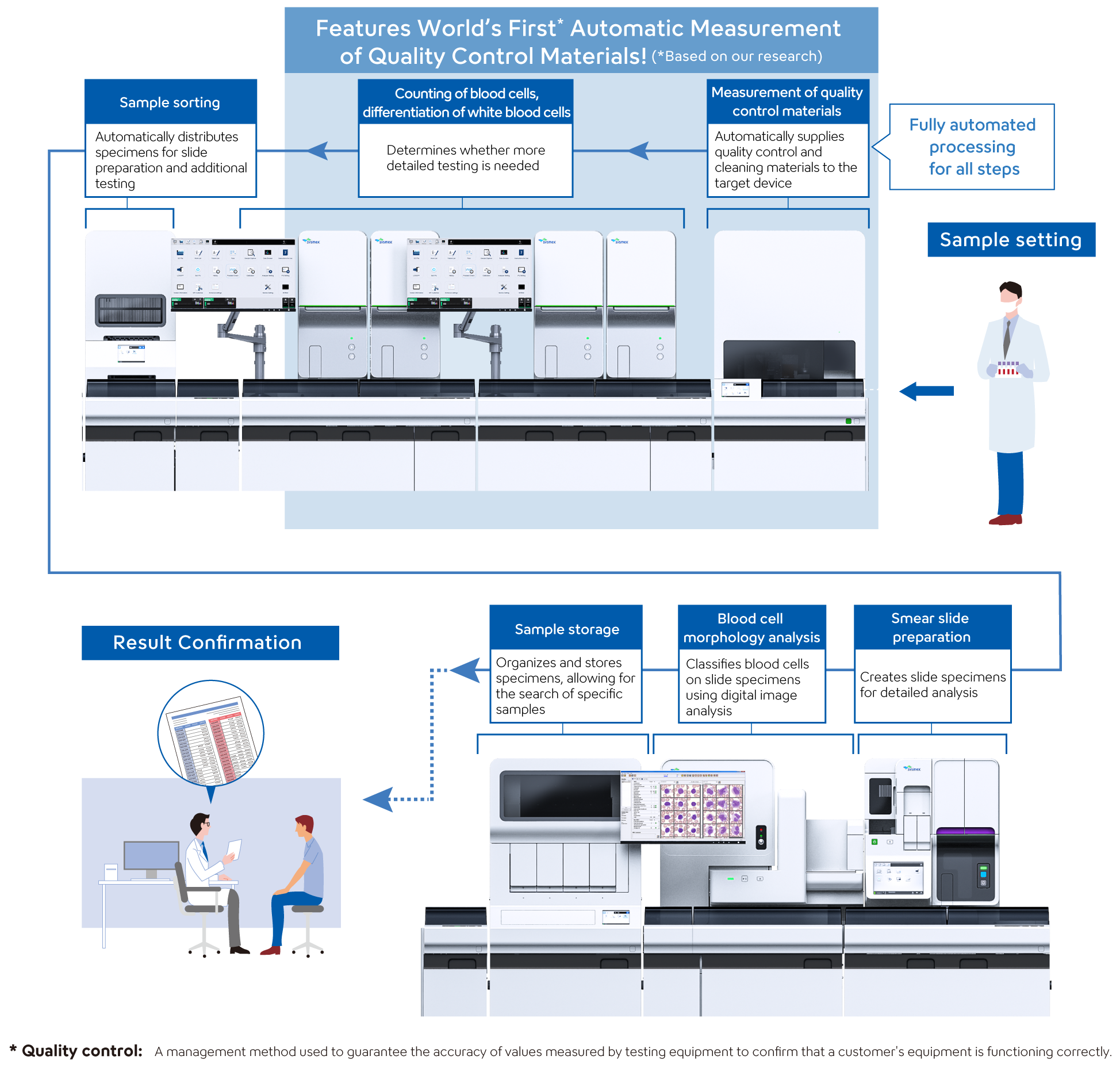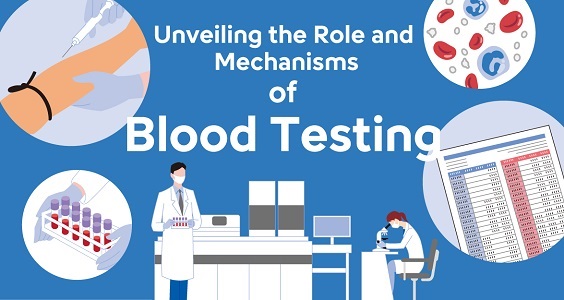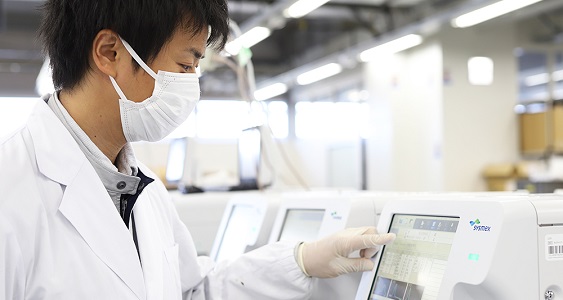Are you familiar with the field of hematology? Hematology is a fundamental field of blood testing that involves analyzing the number, type, and size of red blood cells, white blood cells, and other components to determine if more detailed testing is needed. Sysmex has been a leading company in the field of In vitro diagnostics, including hematology, and has supported medical institutions worldwide for many years.
Building on this extensive experience, we have introduced to the market a hematology system with functionality that is the first of its kind in the world. The foundation of this product development is the touch-free concept, where the entire testing process is completed automatically, without human intervention from start to finish.
In this article, Yuichiro Ohmae, the product development leader, shares insights into the innovative thinking behind the new technology, the product’s development story, and the challenges ahead.
The Development of Touch-Free Technology: A Challenge Driven by the Collective Expertise of the Group
What Do Clinical Laboratories Currently Require?
Due to the declining workforce and the promotion of work-style reforms for doctors, clinical laboratories are urgently required to improve operational efficiency and enhance their capabilities. As a result, there is an increasing demand for product development that can address the challenges and needs of the field more effectively than ever before.
Capturing the True Needs of Medical Settings and Exceeding Customer Expectations
So, how did you come up with the ideas to address these needs and bring innovation to clinical laboratories?
Ohmae: In the past, our product development focused on providing instruments that were easy to use. However, for this project, we started by envisioning the ideal situation for our customers and identifying their potential needs.
Sysmex’s hematology products are widely used in medical institutions across more than 190 countries and regions. Therefore, I believe our strength lies in our ability to gather insights into customer needs and use cases from around the world. By collaborating with various departments and consolidating feedback from clinical laboratories and customers worldwide, we arrived at the touch-free concept—an idea where the entire testing process is performed automatically from start to finish without human intervention.
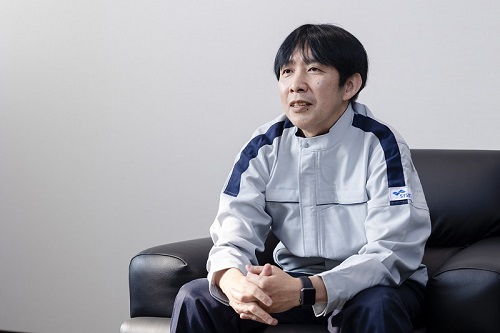
Yuichiro Ohmae, Senior Engineer
Production Design Center
Sysmex Corporation
One area we particularly focused on during our research was QC (Quality Control) operations.* These are preparatory tasks that clinical laboratory professionals must perform before conducting tests to ensure that the instruments are functioning properly. QC operations are a critical process that directly affects the diagnosis and treatment of patients, but they are also time-consuming, taking about an hour each morning. Through the development of technology to automate these QC operations, we succeeded in taking the first step toward achieving a touch-free system.
The development was by no means easy. To ensure that our product could be used with confidence in clinical laboratories worldwide, we paid careful attention to details such as the varying shapes of blood collection tubes and devices in different countries and strict temperature control.
* QC operations typically involve laboratory professionals arriving early in the morning, setting up the testing instruments, removing control materials from the refrigerator to allow them to return to room temperature, and then mixing and placing them into the instruments for measurement.
The Impact Brought by Touch-Free Technology in Healthcare
Contributing to an Environment Where Laboratory Professionals Can Utilize Their Expertise by Reducing Their Workload
The touch-free hematology system has been implemented in many clinical laboratories, both domestically and internationally, since its release. We have received feedback from medical institutions around the world,
“The variation in test data has decreased, and we can now have more confidence in the results.”
“With the automation of QC measurements, the burden on clinical laboratory professionals has been significantly reduced, making operations smoother.”
“We can now allocate resources to more specialized analytical tasks, as well as the training and education of clinical laboratory professionals.”
Ohmae: As a developer, I feel great joy knowing that by reducing the burden on clinical laboratory professionals and improving their working conditions, we are ultimately contributing to better diagnoses and treatments for patients. This is the result of the entire company working together.
At the product launch event in Taiwan, the response was far beyond our expectations. We received high praise from many medical professionals, which made us realize the high expectations for our product.
Shaping the Future of Clinical Laboratories
As demands for further advancements in medical devices grow, including environmental considerations and the use of AI, how do Sysmex developers—whose mission is “Shaping the advancement of healthcare”—envision the future of clinical laboratories?
Ohmae: Sysmex has a broad technological foundation, allowing us to develop everything in-house—from analyzers, reagents, and the transportation systems that connect these processes to the software that controls their integration. I believe our strength lies in the fact that our diverse team of specialized engineers works closely with marketing and academic experts familiar with clinical laboratory environments worldwide to identify potential needs and develop products accordingly.
By expanding our touch-free concept, we aim to eventually achieve the “unmanned labs” of the future, where core operations can be fully automated by our devices without human intervention. If we succeed in creating such unmanned laboratories, it will also help to improve healthcare access in remote areas and regions with limited medical resources. Going forward, we aim to deliver peace of mind to medical professionals and, ultimately, the patients they serve, by leveraging the full strength of our group to pioneer the future of clinical laboratories.
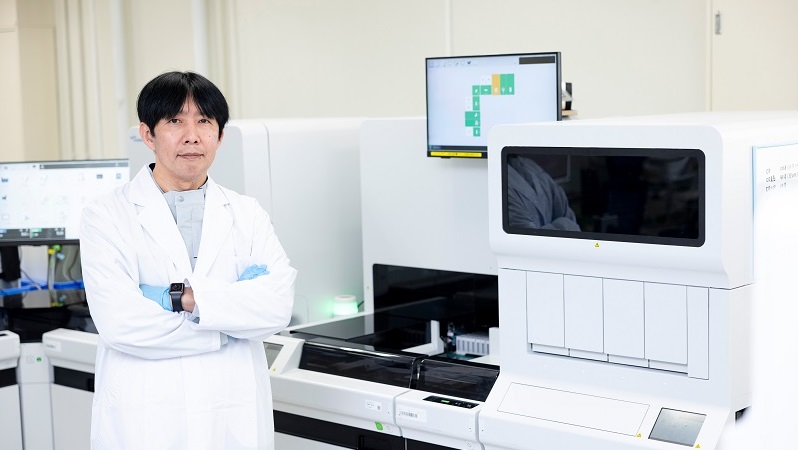
Column: What is a Hematology System? An In-Depth Look at Our Flagship Model
First, it automates tasks such as the supply of quality control and cleaning materials, device startup, and mixing and measuring of control materials. Then, by rearranging the samples based on the required testing steps, the entire sample transportation system’s performance is maximized. After measurements are complete, the samples are stored under different conditions, streamlining subsequent processes like sample management and retrieval.
Related Articles
-
Unveiling the Role and Mechanisms of Blood Testing: How Sysmex Supports Diagnostics in Healthcare
Have you ever wondered where the blood drawn during health checkups or hospital visits goes? Who performs the tests, how are they conducted, and why are blood tests so crucial? In this article, we explore the essential roles and processes of blood tests, and introduce the dedicated professionals and advanced equipment from Sysmex that support these vital diagnostic procedures.
Have you ever wondered where the blood drawn during health checkups or hospital visits goes? Who performs the tests, how are they conducted, and why are blood tests so crucial? In this article, we explore the essential roles and processes of blood tests, and introduce the dedicated professionals and advanced equipment from Sysmex that support these vital diagnostic procedures.
-
Ensuring People’s Health and Preserving the World’s Environment for the Future through Sustainable Product Development
Toward the realization of a sustainable society, Sysmex is working on designing and developing environmentally friendly products. In addition to assuring the quality required for medical devices, we strive to reduce the environmental impact related to those devices. This story introduces the development of one particular product and the thoughts of the person leading that development.
Toward the realization of a sustainable society, Sysmex is working on designing and developing environmentally friendly products. In addition to assuring the quality required for medical devices, we strive to reduce the environmental impact related to those devices. This story introduces the development of one particular product and the thoughts of the person leading that development.
Related Keywords
- Information contained in the stories is current as of the date of the announcement,
but may be subject to change without prior notice.

